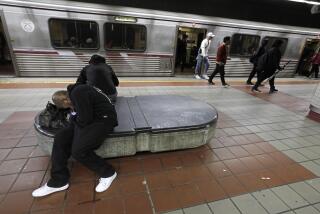No Appetite for Classical Music
- Share via
If you want to get rid of gophers, spend a small fortune on devices that beam sound waves underground and drive rodents mad.
But if it’s rowdy teenagers you would ward off, just throw some Rachmaninoff on the CD, crank up the volume and watch ‘em scatter.
It works.
You can try it at home or you can waltz off to the McDonald’s on Wendy Drive in Newbury Park.
The other day, I sipped coffee at the cement tables outside and listened to the violins going through their frantic paces in Vivaldi’s “The Four Seasons.”
Call it coincidence but there wasn’t a delinquent within earshot.
Not that all teenagers are delinquents or that there is anything wrong with teenagers in general. But while most pursue their studies and gallantly go about the terrible business of adolescence, a few loiter and litter and hang around slack-jawed, scaring old people and generally bringing down the class average. And for these citizens, it has been proved that a dose of Mozart is as garlic to a vampire.
That is why Wayne Herbert, the owner of this new McDonald’s as well as one in Simi Valley, beams Beethoven and the like into the outdoor dining area. (Customers inside were bathed in tepid easy-listening when I stopped by.)
“It seems to work very well,” Herbert said, quickly pointing out that he has had no problems at his new store. Backed up by Johann Sebastian “The Enforcer” Bach, he isn’t looking for any.
Herbert got the idea from 7-Eleven, which pioneered classical music for crowd control at its stores in British Columbia in 1985. Since then, more than 150 7-Elevens have signed on, including one in Oxnard and one in Thousand Oaks.
“We never had what would be called a real problem,” said John Barker, owner of the 7-Eleven on Thousand Oaks Boulevard. “But it was enough. I was hearing too much of employees telling me their friends wouldn’t want to come by after dark because of the people hanging out. This was a nonconfrontational way of dealing with it.”
When I was there, the strains of Debussy’s “Afternoon of a Faun” drifted from three speakers out front into the parking lot. I sat in my car with a 10-gallon Slurpee. In the Oldsmobile next to me, another 50-year-old guy sat with his windows open, his tie loosened, his eyes closed, his thoughts drifting to the lost loves of his youth.
“Where you been Haydn all my life, sugar?” he asks silently.
She drifts out of mind. The man tips over his metallic-blue Slurpee and sits up with a start. That is how it is with middle-aged men loitering to the classics.
“Our regulars say they love coming here because of the music,” Barker said.
Like many others who use music as a weapon in the war on youthful annoyance, Barker gets his classical stuff via satellite from Muzak. Paul Carlson, who is what the Seattle canned-music giant calls an “audio architect,” puts it together.
“Our programming isn’t designed to scare anyone off,” he told me. “We design programs to create an environment, to enhance an ambience. It helps to bring the color out of a lot of places.”
So why does it also help to drain the teens? Why do fast-food places and convenience stores use “The Moonlight Sonata” to do what “No Loitering” signs never could?
Carlson, who was trained as a youth in classical cello and piano, had a theory.
“A teenager might just be challenged,” he ventured. “It might be like giving him a big hug in front of his peers and he goes, ‘Not now, mom!’ Maybe it’s that kind of feeling.”
More to Read
The biggest entertainment stories
Get our big stories about Hollywood, film, television, music, arts, culture and more right in your inbox as soon as they publish.
You may occasionally receive promotional content from the Los Angeles Times.











